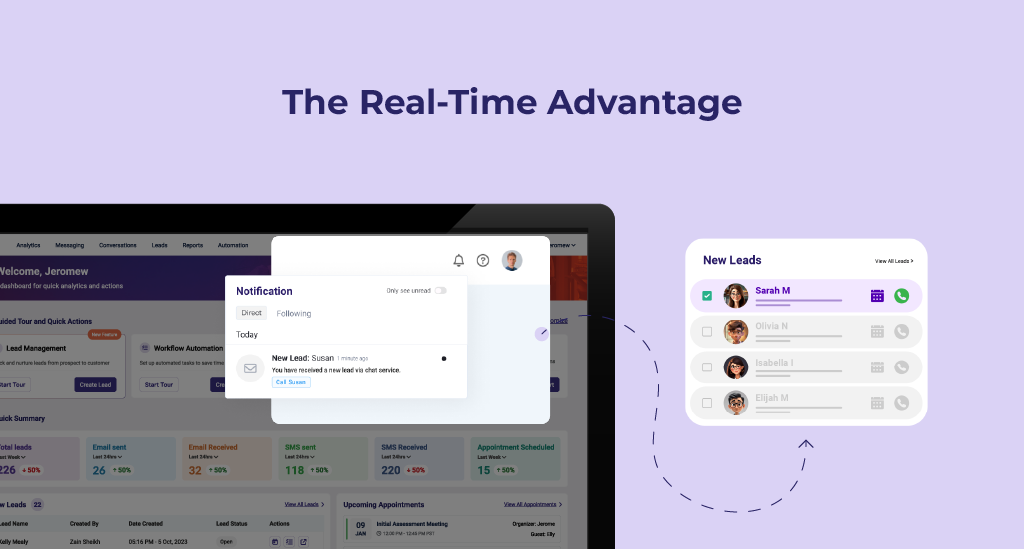Real-Time CRM for Faster Lead Response | Blazeo Advantage

As of March 2024 we have renamed Apexchat to Blazeo. We are excited to share the next part of our journey with our customers and partners.
The name ApexChat implies that we are primarily a chat company, which is no longer true. Now we have many offerings, such as call center services, AI, Appointment setting, SMS Enablement, Market Automation, and Sales acceleration (Q2 2024), that go beyond chat. The new name will not only allow us to convey the breadth of our offering but will also better convey our company’s mission and values.
Blazeo, which is derived from the word Blaze, evokes a sense of passion, speed, and energy. A “Blaze” is captivating, illuminates, and represents explosive growth. Blazeo encapsulates our mission to ignite such growth for our customers and partners by delivering innovation with passion, speed, and energy.


A sales cycle often begins with a fleeting micro-moment. Someone taps a “Request Demo” button after comparing plans. Someone else dials the number on your website because the pain they live with finally outweighs the hassle of switching vendors. In that instant, intent peaks. A buyer is ready to talk, even if they don’t yet know what comes next. The potential for a relationship is alive—and so is the potential for revenue. The only question is whether the business responds fast enough to keep that potential from evaporating.
This is where many organizations quietly lose. They respond eventually, sometimes professionally, often apologetically, always too late. The buyer has already Googled alternatives. A competitor has already replied. Urgency cools into indifference. The conversation begins at a disadvantage that no objection-handling script can reverse.
Missed timing is missed revenue. In today’s market, the delay between intent and action defines the winners.
Traditional CRMs were built to record what happened. Modern ones are being re-imagined to react as it happens. This marks a fundamental shift from retrospective data entry to real-time orchestration—a change that redefines how marketing, sales, and service teams move together.
Real-time CRM doesn’t mean faster notifications or slicker dashboards. It means every buyer signal—form fill, message, ad click, or phone call—is treated as a live event. The system routes the lead intelligently, alerts the right rep instantly, and automates the first touch before attention fades. In other words, it transforms the CRM from a historical ledger into a live engine of responsiveness.
This shift reflects a broader truth: responsiveness is the new personalization. It tells the buyer that their problem matters right now.
Also read: What Modern CRMs Get Wrong — and How to Fix It in 2025
In sales, instant CRM response time is the deciding factor. Waiting even one hour to respond to an inbound lead can reduce your chance of engagement by over 60%. Real-time CRM for sales responsiveness turns this window into an opportunity. Beyond the number, the psychology is simple. Buyers act when motivation spikes. Respond fast, and you meet them at that peak. Respond late, and you meet their hesitation.
Pipeline velocity is a multiplication equation. A quick first move improves qualification rates, shortens deal cycles, and increases close ratios—because momentum never breaks. When repeated across hundreds of interactions, that consistency compounds into predictability and revenue growth.
Yet, most businesses think they respond quickly. Few actually measure it. Median first-touch times of 30 minutes or even two hours quietly cost millions in unrealized revenue. Intent decays faster than most dashboards can update
Picture a buyer named Sarah, searching for a platform to help her operations team work faster. On Saturday morning, she fills a form on Company A’s website. Within minutes, she receives a message offering a quick call or instant calendar slot. By the afternoon, she’s spoken with a rep and feels like she’s found a company that moves at her pace.
That same morning, Sarah contacts Company B. Their system updates periodically. The SDR notices the lead after lunch and sends a polite email the next day. Sarah replies kindly that she’s already leaning toward another vendor.
Both companies had strong messaging. Only one had real-time execution.
Automation fails when it feels robotic. It succeeds when timing makes the human on the other end feel seen.
When a pricing download triggers a short, relevant follow-up, it feels like service—not spam. When a missed call receives an immediate message confirming help is on the way, it signals competence. The magic lies in micro-timing paired with micro-context: what happens and when it happens are equally important.
Buyers want responsiveness, not rehearsed scripts. The future of automation will belong to companies that make speed feel sincere.
Phone calls remain one of the strongest buying signals—and one of the most mishandled. Teams are busy. Weekends go unanswered. Call centers are costly. Voicemail captures excuses instead of opportunities.
Emerging Voice AI systems are changing that by ensuring no call dies waiting. They can answer, qualify, and route in real time, while preserving the warmth of human connection. The aim isn’t to replace people—it’s to preserve opportunities until people can engage.
Voice is quickly becoming the frontier where intent meets intelligence.
Also read: AI Call Answering Software for Businesses: Blazeo Voice AI
Across industries, real-time responsiveness is proving its value.
A mid-market HR tech firm reduced first-response times from hours to minutes and saw a 25% lift in qualified pipeline.
A university admissions office treated weekend inquiries as live events and increased application conversions.
A home-improvement service connected incoming leads directly to the nearest field team, quoting while customers were still looking at the problem that drove the inquiry.
These weren’t psychological tricks—they were operational corrections. Speed revealed what teams were capable of all along.
CFOs don’t buy faster CRMs—they buy measurable revenue impact. Real-time responsiveness turns into ROI when leaders can trace how a five-minute improvement in reply time translates into higher conversion rates and shorter sales cycles.
Tools like ROI calculators now make that connection visible, showing in hard numbers how much revenue evaporates with every minute of delay. When finance teams can see time as money—literally—budget debates become easier.
The same principle applies to marketing. Buyers researching software can detect low-value content instantly. AI-generated filler, duplicate blog structures, and keyword stuffing erode trust before sales ever makes contact.
The most effective brands are publishing material that answers real questions in real time. It’s not about pushing a product; it’s about transferring expertise the moment someone seeks it. That, too, is real-time engagement.
Also read: Cracking Multi-Touch Attribution ROI: Proven Strategies
The transformation doesn’t require a massive overhaul—just intent and measurement. Businesses that start by setting a five-minute response target, aligning lead routing to actual rep expertise, and automating the first touch often see results within a week.
By midweek, their calendars fill earlier in the funnel. By Friday, leadership notices more confident forecasts because momentum is steady, not forced. The cultural shift isn’t about technology alone—it’s about reclaiming time as a competitive advantage.
Q1: What is a real-time CRM?
A real-time CRM instantly processes and responds to buyer actions—like form fills, calls, or clicks—so sales teams engage prospects while intent is high.
Q2: Why is response speed important in sales?
Delays between lead capture and first contact reduce conversion chances. Responding within minutes increases qualification rates and shortens sales cycles.
Q3: How does automation support real-time CRM?
Automation routes leads, triggers alerts, and sends personalized follow-ups instantly, letting reps focus on meaningful conversations.
Q4: Can real-time CRM work for small businesses?
Yes. Many modern CRMs offer real-time features like instant lead alerts, AI call handling, and automated scheduling suitable for any team size.
Q5: How do I measure my response time?
Track first-touch metrics inside your CRM. Set a five-minute benchmark and review response logs weekly to spot delays and fix bottlenecks.
Buyers move on their timelines, not yours. Pipeline momentum exists only in the present moment. Respond quickly, and revenue advances. Pause, and opportunity shifts to whoever showed up first.
Real-time responsiveness isn’t a feature—it’s a philosophy. It’s the discipline of staying present where your buyers already are. The future will belong to businesses that turn intent into action before attention fades.
The next wave of CRMs will make that possible at scale. Blazeo is among those building toward that future—but the real opportunity starts with how fast your team decides to act today.